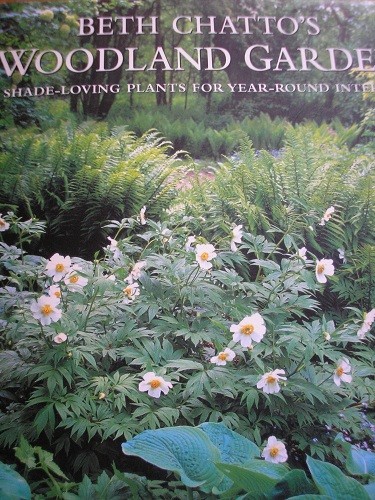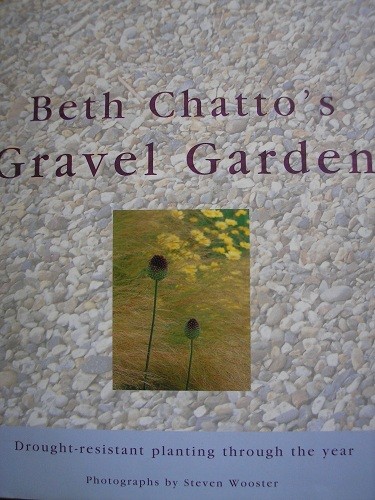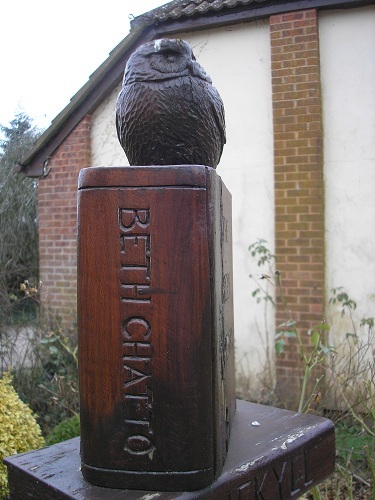Before moving here 20 yrs ago, I just looked after the garden of whichever house we were living in – not really interested – just keeping it tidy. It wasn’t until I was having to come down to Devon, house-hunting, that I saw the most wonderful gardens and discovered what gardening was all about. The first gardening book that I bought, thank goodness, was “The Green Tapestry ” by Beth Chatto, and the scales fell from my eyes.
I now realised why plants that I had bought previously hadn’t survived or flourished – I was planting them in the wrong place ! Beth Chatto is the most inspiring writer, I now have most of her books and they have helped me so much in the choice of plants that I now have, a lot of them bought from her nursery in Essex. Our daughter lived for a while in Essex so of course each time we visited we had to visit Beth Chatto’s garden – fantastic place with super plants in the nursery – always came back with the back of the car full !!
When we bought this house we didn’t really consider the garden, except that I knew I could do something with it, I was willing to learn, no matter what. Most people seem to want a south facing garden with beautiful soil and wouldn’t touch a north facing slope with heavy clay and huge trees on the south side of the house causing a lot of shade. I now realise how lucky we are – our own little bit of woodland to grow plants from the west side of Canada, the Himalayas, China etc. Beautiful foliage plants quite often like a bit of shade for their large leaves and small woodland plants and bulbs revel in the leaf litter and do their growing and flowering before the leaves come on the trees. Small autumn bulbs are happy here too and add to the colour of the autumn tints in this area. This is now a very important area for wildlife, areas for hibernating mammals, rotting logs for beetles and leaf mould for the thrushes and blackbirds to root through. I think this is my favourite part of the garden, there is so much going on here for 10 months of the year.
The next lucky find was an underground stream – one area of the garden always remained soggy and sometimes even boggy ! The plants that the previous owner had planted were either dead, dying or not looking very happy – she had planted shrubs and trees that like well drained soil. Out they came and moved across the garden to where the soil was drier. These were replaced with perennial bog plants that have never looked back and look very happy indeed !! It was also the obvious place to make our pond so this is now another important area of the garden for the wildlife. Gardening books and magazines advise that such areas should be drained – apart from being such hard work and expensive – how much nicer to have an area where lush bog plants can be grown and frogs, toads and newts can be safe and happy.
Another area that we are developing for wildlife is our circular lawn which is very wet all winter – it has the underground stream running underneath !I have planted it with Snakeshead fritillaries and hope to add some cowslips grown from seed in the future. Sometimes in the past we have allowed the grass to grow longer to have a spring meadow, but we mow round the edge twice with the lawn mower and then mow a path through the centre. It is amazing , the variety of plants which flower and attract insects, which in turn brings in the birds and the bats. Also different butterflies come to lay their eggs on the longer grass. The only downside is that when the grass is eventually cut and turned back from meadow into lawn, it looks very yellow for a few weeks before it greens up again, a small price to pay.
We have a wildflower bank and scree bed, the only well drained bits in this garden! The bank is what is known as a Devon bank. Fields and woodlands here were quite often edged with these banks hundreds of years ago to mark their boundaries . Our garden was once part of the field which is next door and the little strip of woodland edges the road through the village, which at some time was probably just a track. I have been planting up these banks with wildflowers, all north facing banks but it is surprising what seems to enjoy them. The bank that is in the fruit and vegetable garden gets a lot of light and has bulbs for the beginning of the year as well as flowers later. This is to attract the bees so that they will pollinate the fruit trees and bushes as well as the flowers on the bank. Our tiny scree is the old raised pond by the house ( built by the previous owners ) which we filled with very gritty soil when we made the new pond by the bog garden. I keep this bed for the plants that really demand fantastic drainage in the sun and it means of course that I can grow a completely different range of plants from the rest of the garden.
It is thanks to Beth Chatto and her books that I have learnt how to plant each different area of the garden – without her looking over my shoulder and inspiring me, I would have planted everything in the wrong place and not thought about where the plant originated in the wild and the sort of conditions that they are happy in. If you have been reading previous posts you will have seen a carving of mine of gardening books with an owl on top. The owl is sitting on the book of ” The Green Tapestry” by Beth Chatto – my ” thank you” to a great gardener for inspiring me to make this garden.





